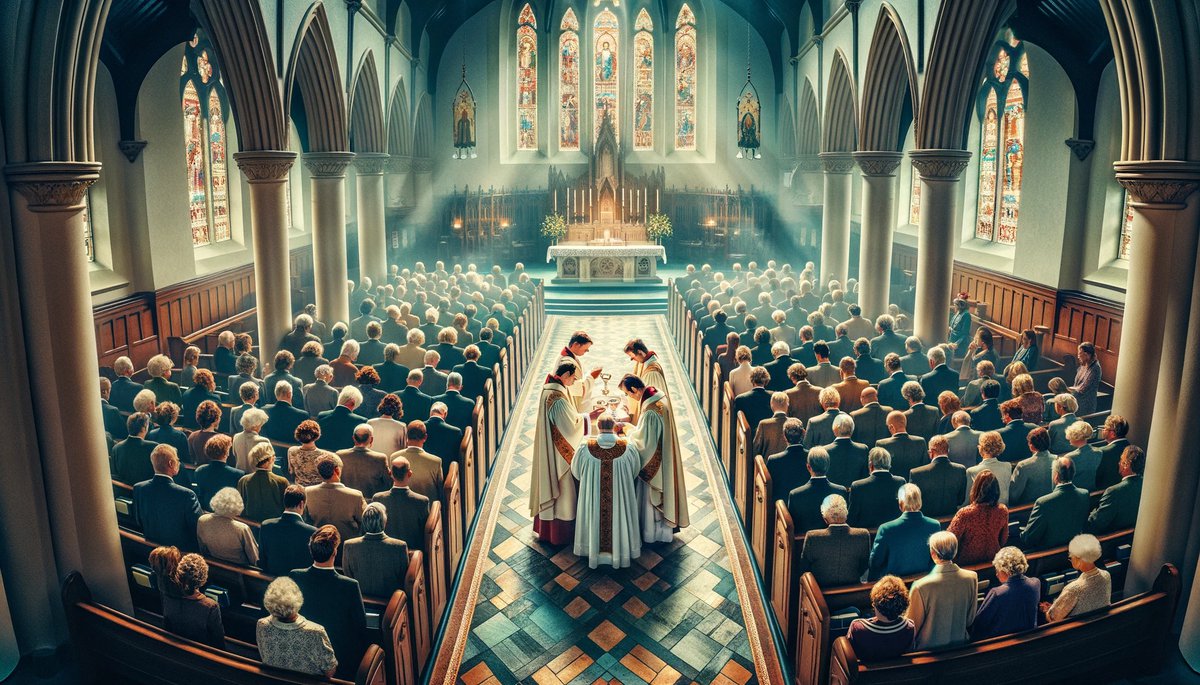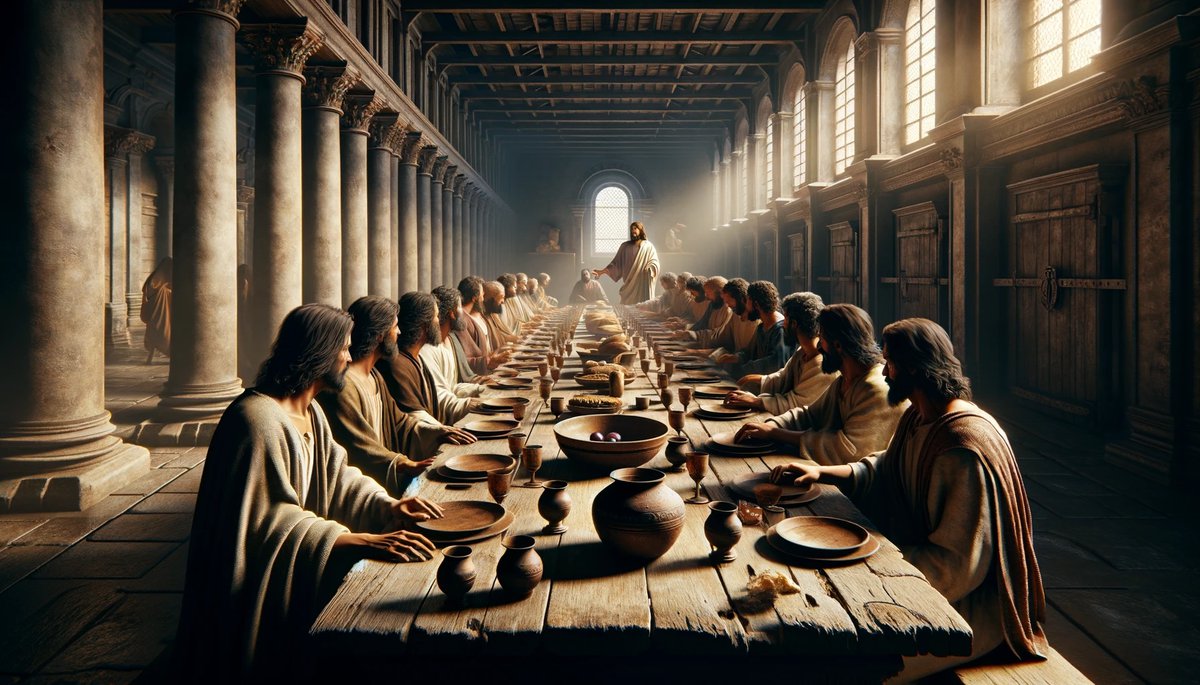Home>Theology and Spirituality>Why Is White Worn At First Communion


Theology and Spirituality
Why Is White Worn At First Communion
Published: February 25, 2024
Jason DeRose, Managing Editor at Christian.net, uses his expertise in religion and journalism to deepen understanding of faith's societal impacts. His editorial leadership, coupled with a strong academic background, enriches the platform’s diverse content, earning him recognition in both journalism and religious circles.
Discover the significance of wearing white at First Communion and its connection to theology and spirituality. Explore the traditions and symbolism behind this sacred ceremony.
(Many of the links in this article redirect to a specific reviewed product. Your purchase of these products through affiliate links helps to generate commission for Christian.net, at no extra cost. Learn more)
Table of Contents
Introduction
The First Communion ceremony is a significant milestone in the lives of young Christians, marking their initiation into the sacramental life of the Church. One of the most striking and enduring traditions associated with this sacred event is the attire worn by the communicants, particularly the prevalence of white garments. The choice of white for First Communion attire holds deep historical, symbolic, and cultural significance, reflecting the spiritual purity and reverence associated with this sacred rite.
The tradition of wearing white at First Communion dates back centuries and is rooted in the historical practices of the early Christian Church. White has long been associated with purity, innocence, and holiness, making it a fitting choice for this momentous occasion. The symbolism of white attire extends beyond mere aesthetics, serving as a visual representation of the spiritual purity and inner cleansing that precedes the reception of the Eucharist.
As the communicants prepare to partake in the body and blood of Christ for the first time, the white garments they don symbolize their desire to approach this sacred sacrament with hearts cleansed of sin and minds open to the divine grace offered through the Eucharist. This symbolic gesture underscores the solemnity and reverence with which the First Communion is approached, emphasizing the spiritual significance of the event for both the communicants and their families.
The tradition of wearing white at First Communion is not merely a matter of symbolism; it also reflects the cultural and traditional customs that have been passed down through generations within Christian communities. The choice of white attire for this occasion is often deeply ingrained in the cultural heritage of the families and communities celebrating the sacrament, adding a sense of continuity and tradition to the joyous festivities surrounding the First Communion ceremony.
In the subsequent sections, we will delve deeper into the historical, symbolic, and cultural significance of white attire in the context of First Communion, exploring the multifaceted reasons behind this cherished tradition and its enduring relevance in modern times.
Historical significance of white clothing in religious ceremonies
White clothing has held profound significance in religious ceremonies across various cultures and faith traditions throughout history. The use of white garments in religious rites predates Christianity and can be traced back to ancient civilizations, where white was associated with purity, divinity, and spiritual enlightenment.
In the context of Christianity, the tradition of wearing white for religious ceremonies has deep roots in the early Church. The symbolism of white as a representation of purity and holiness is evident in the New Testament, where white garments are associated with divine radiance and spiritual transformation. The transfiguration of Jesus, as described in the Gospels, portrays him clothed in dazzling white, signifying his divine nature and the glory of God.
Early Christian communities adopted the use of white garments for baptism, the Eucharist, and other sacred rituals, drawing upon the symbolic significance of white as a visual expression of spiritual rebirth and the forgiveness of sins. The act of donning white attire for these ceremonies symbolized the shedding of the old self and the emergence of a new, purified identity in Christ.
The association of white with purity and spiritual renewal also found resonance in the teachings of prominent Church fathers and theologians. St. Augustine, for instance, emphasized the transformative power of baptism, likening the newly baptized to "infants clothed in white," signifying their innocence and newfound purity in the eyes of God.
As Christianity spread and evolved, the tradition of wearing white for religious ceremonies became more entrenched, with specific liturgical vestments and garments designated for priests, deacons, and other clergy members. The use of white vestments during the celebration of the Eucharist and other solemn occasions underscored the enduring symbolism of white as a visual representation of the divine presence and the sanctity of the sacraments.
In summary, the historical significance of white clothing in religious ceremonies, including the First Communion, is deeply rooted in the rich tapestry of Christian tradition and symbolism. The enduring legacy of white attire as a symbol of purity, spiritual rebirth, and the divine presence continues to imbue religious rituals with profound meaning and reverence, connecting contemporary believers to the timeless heritage of their faith.
Symbolism of white in the context of First Communion
The symbolism of white attire in the context of First Communion encompasses profound spiritual significance, reflecting the purity, innocence, and reverence associated with this sacred sacrament. The choice of white garments for this momentous occasion is laden with symbolism that transcends mere aesthetics, serving as a powerful visual representation of the spiritual journey undertaken by the communicants as they prepare to receive the Eucharist for the first time.
White, universally recognized as a symbol of purity and cleanliness, holds particular relevance in the context of First Communion. The communicants, often young children, are encouraged to approach this sacred rite with hearts cleansed of sin and minds open to the divine grace offered through the Eucharist. The white attire they don symbolizes their earnest desire to partake in this holy sacrament with a sense of spiritual purity and inner sanctity, aligning with the teachings of Christ regarding the innocence and humility required to enter the kingdom of heaven.
Moreover, the symbolism of white in the context of First Communion extends beyond individual purity to encompass communal unity and spiritual renewal. As the communicants gather to partake in the body and blood of Christ, their white attire serves as a unifying symbol of their shared faith and their collective participation in the sacred mysteries of the Eucharist. It signifies their belonging to the larger Christian community and their commitment to upholding the values of love, compassion, and spiritual devotion exemplified by Jesus Christ.
Furthermore, the symbolism of white in the context of First Communion resonates with the scriptural imagery of the wedding feast of the Lamb, as described in the Book of Revelation. The communicants, adorned in white garments, symbolize the purity and readiness of the Church as the bride of Christ, preparing to partake in the eternal communion with the divine. This profound symbolism underscores the sacred union between the communicants and Christ, emphasizing the transformative power of the Eucharist in nourishing their souls and strengthening their bond with God and the Christian community.
In essence, the symbolism of white in the context of First Communion encapsulates the spiritual purity, communal unity, and divine communion inherent in this sacred sacrament. The white attire worn by the communicants serves as a tangible expression of their inner readiness to receive the body and blood of Christ, embodying the timeless values of innocence, humility, and spiritual devotion that lie at the heart of the Christian faith.
Cultural and traditional reasons for wearing white at First Communion
The cultural and traditional significance of wearing white at First Communion is deeply intertwined with the customs and practices that have been cherished within Christian communities for centuries. Across diverse cultural landscapes, the choice of white attire for this sacred occasion reflects a tapestry of traditions, beliefs, and symbolic meanings that enrich the experience of the communicants and their families.
In many cultures, the tradition of dressing communicants in white for their First Communion is a reflection of the profound spiritual significance attached to this milestone. White, universally recognized as a symbol of purity and innocence, aligns with the spiritual ideals upheld by the Christian faith. The communicants, often young children, are adorned in white garments to symbolize their spiritual readiness and inner purity as they prepare to receive the Eucharist for the first time. This tradition underscores the aspirational journey of the communicants as they strive to embody the virtues of humility, innocence, and reverence in their approach to the sacrament.
Furthermore, the cultural and traditional reasons for wearing white at First Communion extend beyond individual symbolism to encompass familial and communal traditions. In many Christian families, the tradition of dressing children in white for their First Communion is a cherished custom that carries deep familial significance. The white attire worn by the communicants often holds sentimental value, passed down through generations as a symbol of familial heritage and spiritual continuity. This tradition fosters a sense of shared identity and tradition within the family, reinforcing the spiritual values and beliefs that bind them together.
Moreover, the cultural and traditional reasons for wearing white at First Communion are often intertwined with regional customs and practices that imbue the ceremony with unique cultural flavors. In some communities, the design and embellishments of the white attire may reflect local artistic traditions, adding a touch of cultural richness to the celebratory event. The incorporation of traditional motifs, embroidery, or accessories into the white garments further underscores the fusion of cultural heritage and religious significance, creating a visually captivating tapestry of tradition and faith.
In essence, the cultural and traditional reasons for wearing white at First Communion encompass a rich tapestry of spiritual, familial, and regional customs that imbue the sacred ceremony with profound meaning and cultural resonance. The choice of white attire for this momentous occasion serves as a testament to the enduring legacy of tradition, faith, and communal celebration within Christian communities across the globe.
Modern interpretations and variations in First Communion attire
In contemporary times, the traditional practice of wearing white at First Communion has evolved to encompass a diverse array of interpretations and variations in attire, reflecting the dynamic interplay between cultural influences, fashion trends, and individual expressions of faith. While the symbolic significance of white as a representation of purity and spiritual readiness remains central to the tradition, modern interpretations have introduced a spectrum of styles, designs, and cultural nuances that enrich the visual tapestry of First Communion attire.
One notable trend in modern First Communion attire is the fusion of traditional and contemporary elements, giving rise to garments that strike a balance between timeless elegance and contemporary aesthetics. While the foundational symbolism of white remains paramount, modern designs often incorporate elements of modern fashion, such as updated silhouettes, embellishments, and fabric choices, to cater to evolving tastes and style preferences. This fusion of tradition and modernity allows communicants to express their individuality while honoring the sacred significance of the occasion.
Furthermore, cultural diversity has contributed to a rich tapestry of variations in First Communion attire, with different regions and ethnic communities infusing their unique cultural motifs and design sensibilities into the white garments. From intricate lacework and embroidery to traditional patterns and motifs, the modern landscape of First Communion attire reflects a vibrant mosaic of cultural expressions, celebrating the diversity of global Christian traditions.
In addition to stylistic variations, modern interpretations of First Communion attire also embrace inclusivity and accessibility, ensuring that communicants from diverse backgrounds and economic means have access to meaningful and dignified attire for this sacred occasion. Initiatives promoting affordability, sustainability, and inclusivity have led to the availability of a wide range of options, allowing families to select attire that resonates with their values while accommodating their individual circumstances.
Moreover, the advent of online platforms and specialized retailers has expanded the accessibility of First Communion attire, offering a plethora of choices that cater to varying preferences and budget considerations. This accessibility has empowered families to explore a myriad of options, from traditional ensembles to contemporary designs, enabling them to select attire that aligns with their cultural, religious, and sartorial inclinations.
In essence, the modern landscape of First Communion attire reflects a harmonious blend of tradition, diversity, and inclusivity, embracing the evolving dynamics of contemporary culture while honoring the timeless symbolism of white as a visual embodiment of spiritual purity and reverence. This evolution underscores the enduring relevance of First Communion as a sacred rite while celebrating the richness of cultural expressions and individual interpretations within the global Christian community.
Read more: When Is First Communion Held
Conclusion
In conclusion, the tradition of wearing white at First Communion embodies a profound tapestry of historical, symbolic, cultural, and modern significance, reflecting the enduring resonance of this sacred sacrament within the Christian faith. From its historical roots in the early Christian Church to its contemporary interpretations in a diverse and interconnected world, the symbolism of white attire at First Communion encapsulates the timeless values of purity, innocence, and spiritual readiness that lie at the heart of this sacred rite.
The historical significance of white clothing in religious ceremonies, including the First Communion, underscores the enduring legacy of white as a symbol of purity, spiritual rebirth, and the divine presence. This rich historical backdrop provides a deeper understanding of the enduring symbolism of white attire in the context of First Communion, connecting contemporary believers to the timeless heritage of their faith and the profound spiritual significance attached to this sacred sacrament.
Furthermore, the symbolism of white in the context of First Communion resonates with profound spiritual significance, symbolizing the purity, innocence, and communal unity inherent in this sacred sacrament. The choice of white attire serves as a tangible expression of the communicants' inner readiness to receive the body and blood of Christ, embodying the timeless values of innocence, humility, and spiritual devotion that lie at the heart of the Christian faith.
The cultural and traditional reasons for wearing white at First Communion highlight the deep familial, regional, and communal customs that enrich the experience of the communicants and their families. This tradition fosters a sense of shared identity and tradition within the family, reinforcing the spiritual values and beliefs that bind them together, while also reflecting the unique cultural flavors and artistic traditions of diverse Christian communities.
In the modern landscape, the evolution of First Communion attire reflects a harmonious blend of tradition, diversity, and inclusivity, embracing the evolving dynamics of contemporary culture while honoring the timeless symbolism of white as a visual embodiment of spiritual purity and reverence. This evolution underscores the enduring relevance of First Communion as a sacred rite while celebrating the richness of cultural expressions and individual interpretations within the global Christian community.
In essence, the tradition of wearing white at First Communion transcends mere aesthetics, serving as a powerful symbol of spiritual purity, communal unity, and reverence for the sacred mysteries of the Eucharist. This cherished tradition continues to resonate deeply within Christian communities, weaving together the threads of history, faith, culture, and individual expression into a tapestry of profound significance and enduring relevance.














